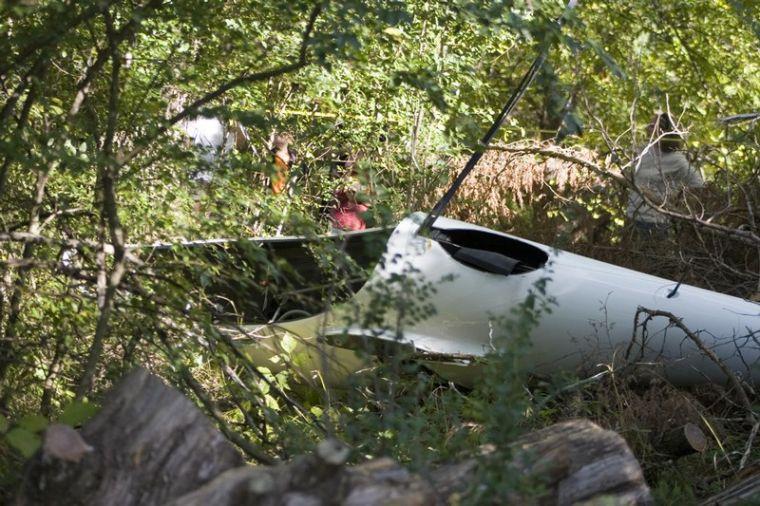Government investigators and Mississippi State officials are looking into the Wednesday crash of an experimental glider that nearly left a campus staff member dead after his parachute failed to open immediately.
For two minutes David Lawrence, the pilot of the crashed plane, was unable to get his parachute open, as he dropped from the sky at a speed of 100 mph. About 500 feet above the surface and less than five seconds from almost certain death, Lawrence’s chute opened.
“He came through a tree and landed on soft ground. He was very lucky,” said Tony Vizzini, head of Mississippi State’s aerospace engineering department.
Referred to as the Owl because of its quietness, the ultra-light, single-manned glider lost both of its wings before deploying its parachute and crashing in the backyard of a house at North Jackson Street and Hospital Road at 3:13 p.m.
The Starkville Police Department tracked the plane as it floated to the ground. Police Chief David Lindley said his squad was at the crash site 90 seconds after the fuselage landed. “Everyone still thought the pilot was inside [the fuselage],” Lindley said on the scene Wednesday.
One of those was Vizzini, who made a mad rush from his office in stricken fear.
“I ran out of my office. We had a concern that …,” Vizzini said, unable to utter the words about his constituent. Lawrence was later found about a mile from the fuselage with minor cuts and bruises. He was transported to the Oktibehha County Hospital shortly after hitting the ground.
“He’s doing fine,” said MSU spokeswoman Maridith Geuder. “He’s real thankful to walk away from it.”
The cause of the accident remains unknown, except that a structural failure caused the wings to detach. The glider’s parachute can normally only be deployed by the pilot, but because of the failure in the wings, the plane’s parachute opened. Vizzini said it landed gently but is not repairable.
“It’s a total loss of an aircraft,” said Vizzini, who was unsure of the glider’s cost but suggested that the price is between $70,000 and $200,000.
One of the glider’s 30-pound wings was found southwest of the Oktibbeha County Hospital in a neighborhood, but the other is missing. John Johnson, a senior program engineer, said the aerospace engineering department will perform a ground search for the missing wing today. The department is also conducting an investigation into the crash by using massive amounts of data it obtained, Johnson said.
The National Transportation Safety Board, the organization responsible for investigating all transportation accidents in the United States, will also begin an investigation. Because it was a flight test and there were no fatalities, the crash is not a priority, said Hector Casanova, the director of the NTSB South Central Regional Office in Arlington, Texas.
“We don’t have a high level of interest,” Casanova said. “We are not traveling to the accident because of personnel shortages.”
He said a preliminary report will be released early next week with general information about the incident. In 60 to 90 days a final report will be released, giving a further explanation of the reason for the malfunctions.
The NTSB, which handles 2,000 accidents a year, will interview Lawrence and may even confiscate the plane parts for use in its investigation.
Lawrence is the director of MSU’s Raspet Flight Research Lab, which developed the plane. This was the third flight test of the Owl, Vizzini said. Raspet finished ground tests of the 155-pound craft in 2005.
A story about the aircraft released by University Relations in February has Lawrence describing the plane’s purpose.
“Its primary mission is to improve communications on the battlefield, but it may spin off a vehicle for other missions such as homeland security and border patrol,” Lawrence said in the release.
The UV-powered Owl, designed and built by Windward Performance of Bend, Ore., has a climb rate of about 700 feet per minute and is expected to operate initially at altitudes from 10,000 to 20,000 feet, the release said.
“A small engine will keep it aloft when needed, but most power will be provided by thermal updrafts and other atmospheric winds,” Johnson said in the release.
Robyn Richardson contributed to this article.
MSU ‘Owl’ crashes
The wingless body of the experimental glider rests in a Starkville resident’s backyard. MSU’s aerospace engineering department is studying the glider’s pieces.
Kat Lawrence
A glider from MSU Raspet Flight Lab crash-landed in a Starkville resident's backyard Wednesday.

























































































